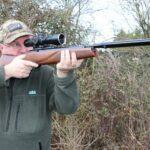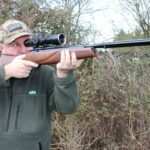Open sights have been a crucial component of firearms for centuries. Despite advancements in technology, they remain a popular choice among shooters of all skill levels. Whether you are a seasoned marksman or a novice, having a solid understanding of the different types of open sights, their workings, advantages, disadvantages, and how to use them effectively can significantly improve your accuracy and overall performance.
In this article, we will delve into the world of open sights and provide you with a comprehensive guide to help you make the most out of this crucial component of your firearm.
Table of Contents
What Are Open Sights?

Credit: Envato Elements/ microgen
Open sights, also called iron sights, are an integral part of rifles, shotguns, and handguns. They offer a straightforward aiming mechanism that does not rely on batteries to function. They are often mandatory by law in specific hunting situations and are typically made of robust metal materials to withstand the rigors of regular use.
Open sights are made up of two components: a front sight and a rear sight. The front sight is a fixed post or bead that is positioned at the end of the barrel or on a ramp near the muzzle. The size and shape of the front sight can vary depending on the type of firearm and its intended use. For example, a shotgun used for bird hunting may have a larger front bead, while a rifle used for precision shooting may have a thinner, more precise front post. The rear sight, on the other hand, is typically a notched plate or aperture that is mounted on the barrel or receiver. Some open sights may have a basic notch in the rear sight, while others have a more complex aperture that can be adjusted for windage and elevation.
To aim using open sights, a shooter lines up the front sight with the rear sight, aligning them with the target. This process is known as “sighting in” the firearm. Once correctly aligned, the shooter can aim and discharge the weapon.
The Benefits of Using Open Sights

Credit: Envato Elements/ valeriygoncharukphoto
Open sights offer several benefits compared to other types of sights. Some of these benefits include:
1) Cost-Effective
Open or iron sights are generally much less expensive than other types of sights, such as telescopic sights or red dots, making them a popular choice for beginner shooters or those on a budget. By choosing these sights, shooters can enhance their accuracy and shooting skills without breaking the bank.
2) Lightweight
Other types of sights, such as telescopic or red dot sights, tend to be heavy which can be burdensome, causing discomfort and strain on the shooter’s arms, shoulders, and back. Open or iron sights, on the other hand, are significantly lighter, allowing the shooter to move and aim their weapon with greater ease and accuracy. This reduction in weight also reduces the likelihood of fatigue on the shooter’s body, enabling them to remain focused and alert for more extended periods, resulting in better shooting performance.
3) Does Not Require Batteries
Open sights have a significant advantage over electronic sights in that they do not require batteries or electricity to function. This means that they can be used in any environment, without the worry of the batteries running out or malfunctioning.
Additionally, since these sights do not have any electronic components, they are not susceptible to electronic interference. This makes them an excellent option for shooting in areas with high levels of electromagnetic waves, such as areas with high-voltage power lines or around electronic devices.
4) Quick Target Acquisition
One of the key advantages of open or iron sights is their ability to facilitate quick target acquisition. In hunting or self-defense scenarios, every second counts, and the simplicity of open sights can prove to be a vital factor in reacting quickly. By merely aligning the front and rear sights with the target, the shooter can quickly and efficiently acquire their target, without the need for additional adjustments or sighting mechanisms.
5) Durability
Open sights are renowned for their durability, making them an excellent choice for shooters who require a rugged and reliable aiming device. Unlike electronic sights, which can be sensitive to impacts or exposure to harsh environments, these sights are typically made of high-quality materials and designed to withstand the rigors of frequent use in various environments. The robust construction also makes them less likely to malfunction or require maintenance, providing shooters with a reliable and low-maintenance aiming device.
6) Consistent Accuracy
Open or iron sights are simple and reliable, which can lead to consistent accuracy in shooting. With practice and proper alignment, shooters can achieve consistent accuracy with open sights, even at longer distances. This consistency can be particularly important for hunters or target shooters who need to hit their target with precision.
The Different Types of Open Sights

Credit: Envato Elements/ ASphotostudio
The four main types of open sights are v-notch sights, u-notch sights, buckhorn sights, and semi-buckhorn sights. Here’s a brief description of each:
1) V-Notch Sights
V-notch sights are one of the most common types of open sights, and they’re often found on pistols and rifles. As the name suggests, they feature a V-shaped notch cut into the rear sight, which serves as the aiming point. The front sight is typically a post or bead that is centered in the V-notch. To aim, you need to align the top of the front sight with the bottom of the V-notch on the rear sight, and then center the front sight in the notch.
V-notch sights are popular for their simplicity and accuracy at short and medium ranges. However, they are not very precise, and you cannot adjust them for windage or elevation.
2) U-Notch Sights
U-notch sights are similar to V-notch sights, but they feature a U-shaped notch instead of a V-shaped notch. This type of sight is often found on shotguns and rifles intended for target shooting or hunting purposes. To aim, you need to align the top of the front sight with the top of the U-notch on the rear sight, and then center the front sight in the notch.
The U-shaped notch on U-notch sights offers an advantage over V-notch sights by helping to frame the target, simplifying the aiming process. While these sights are not as precise as other sighting options and cannot be adjusted for windage or elevation, they still offer greater precision than V-notch sights.
3) Buckhorn Sights
Buckhorn sights are a type of open sight that is often found on lever-action rifles. They feature a curved notch with a small protrusion in the center that serves as the aiming point. To aim, you need to align the front sight with the center of the buckhorn notch.
Buckhorn sights are well-suited for fast shooting at close to medium ranges, but they can be challenging to use for more precise shooting at longer ranges.
4) Semi-Buckhorn Sights
Semi-buckhorn sights are similar to buckhorn sights, but they have a flatter, less curved notch. This type of sight is often found on bolt-action rifles, and it’s preferred by some shooters for its versatility and accuracy at longer ranges. To aim, you need to align the front sight with the top of the semi-buckhorn notch.
Which Open Sight Should You Choose?

Credit: Envato Elements/ Vailery
The type of open or iron sight that you should choose depends on a variety of factors, including personal preference, shooting style, and the intended use of the firearm.
For those who prioritize simplicity and ease of use, V-notch sights are a good choice. They are suitable for handguns and rifles and are commonly used for close to medium-range shooting, including self-defense, hunting, and recreational target shooting. They are also ideal for shooting in low-light conditions, as the contrast between the front and rear sights is easy to see.
For those who require greater precision and accuracy, U-notch sights are a better option. They are particularly useful for shotguns and rifles that are used for target shooting or hunting, where precise aiming is critical. The U-shape of the notch provides a more precise aiming point than V-notch sights, making them suitable for longer ranges.
Buckhorn sights are ideal for shooters who need to quickly acquire and aim at targets at close to medium ranges. These sights are frequently used in lever-action rifles used for hunting or fast-paced shooting sports. However, they are not recommended for precise shooting or longer ranges because the curved notch can make it challenging to align the front sight with the target accurately.
On the other hand, semi-buckhorn sights provide a more versatile and accurate open sight for shooting at longer ranges. They are commonly found on bolt-action rifles used for target shooting or hunting. The flatter, less curved notch on the rear sight provides a more precise aiming point than a buckhorn sight. Although these sights are suitable for longer ranges, they can also be used for close to medium-range shooting.
Step-by-Step Guide on How to Use Open Sights Effectively

Credit: Envato Elements/ Vailery
Now that you know the different types of open sights and which one is best suited for you, here is a step-by-step guide on how to use them effectively:
1) Begin by Properly Aligning the Sights
Before using open sights, make sure they are properly aligned for your firearm. Adjust the rear sight so that the front sight post is centered in the notch. If the sights are misaligned, you will not be able to aim accurately, and your shots will miss the target.
2) Assume a Stable Shooting Position
Stand in a stable position with your feet shoulder-width apart and your body slightly leaned forward. Place your dominant hand on the grip of the firearm, and your non-dominant hand under the barrel or foregrip for support.
3) Bring the Firearm Up to Your Shoulder
Bring the firearm up to your shoulder while maintaining a stable shooting position. Ensure that the butt of the firearm is pressed firmly against your shoulder, and your cheek is resting against the stock of the firearm.
4) Focus on the Front Sight
When aiming with open or iron sights, it is important to focus on the front sight. The target and rear sight should be hazy while the front sight should be clear. This helps you aim accurately.
5) Maintain a Consistent Sight Picture
Once the sights are aligned and you have focused on the target, focus on maintaining a consistent sight picture. This means keeping the front and rear sights in the same position relative to each other and the target throughout the firing sequence.
6) Squeeze the Trigger
With your sights aligned and your firearm aimed at the target, squeeze the trigger gently. Avoid jerking or flinching, as this can cause your shot to miss the target.
7) Follow Through
After firing the shot, continue to focus on the front sight and keep the firearm steady for a moment before lowering it. This helps you to ensure that your shot was accurate and can help you make any necessary adjustments to your aim for future shots.
3) Practice, Practice, Practice
Using open or iron sights effectively takes practice. Make sure to spend time at the range honing your skills and becoming familiar with the sights and the shooting process. Shooting at different distances and in different lighting conditions can also be beneficial. By practicing frequently, you can develop muscle memory and ultimately enhance your precision.
Summary
Open sights are an integral component of firearms, and selecting the appropriate sight is vital to improving your shooting experience. With a diverse range of open sights available, it’s crucial to evaluate your shooting needs and preferences. Whether you use your firearm for hunting, target shooting, or self-defense, there’s an open sight that suits your requirements.
Once you have selected the right open sight for your firearm, it’s time to practice your shooting skills. That’s where EasyShot shooting targets come in handy. At EasyShot, we offer a variety of high-quality shooting targets that can help you improve your accuracy and precision. With durable construction and multiple designs, our targets are perfect for all types of shooting practices. Check us out today!











































